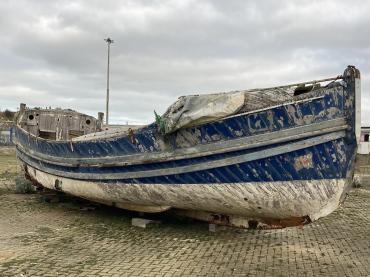Previous names
- 1909 - 1931 Charterhouse
- 1932 - 2009 Marian
- 2009 - 2019 Charterhouse
Details
Construction
Dimensions
History
CHARTERHOUSE was a self-righting lifeboat (Official Number 563) built by the Thames Ironworks , Shipbuilding and Engineering Company. Planning started in 1904 and building was completed in 1908. She served the RNLI station in Fishguard from 1909 to 1930 and was one of the first three Motor Lifeboats ever designed and built to have a motor from the drawing board stage. She was funded by pupils, staff and parents of Charterhouse school.
Once retired she was sold in February 1931 to Sandell Bros from Southampton and was converted into the motor yacht Marian and re-fitted with a cabin and a diesel engine. She sailed extensively in the south of England before being sold to a family in North Wales where she was chiefly used as a holiday house boat, based for many years in North Wales, first at Conway and then at Port Penrhyn, Bangor.
She was in service through the First World War and was launched six times during those years. Once was even to the assistance of an airship, which she seemed to chase for over four hours, though no details are known. Another launch, on February 20 1917, was to the rescue of the Steam Ship Leysian of Liverpool. Accounts vary as one suggestion is that the vessel was chased onto the rocks by a U-boat patrolling near Strumble Head; another that, in thick fog, Strumble Head was mistaken for St. David’s Head. However CHARTERHOUSE was at sea for 14 hours and landed a total of 39 people in three round trips. The SS Leysian was stuck on the rocks for the next eight months before breaking up.
In 2009 she was donated by the owner to the Charterhouse Returns Trust for display in Fishguard & Goodwick with the objective of exhibiting her near her original home of the Fishguard Lifeboat Station. She was taken to Goodwick, where her conservation work began (the pleasure yacht superstructure was removed) and re-christened CHARTERHOUSE. The plan was to make her the centre-piece of a new marina to be built in Fishguard, but this plan was eventually shelved.
Ownership of CHARTERHOUSE was transferred from the Charterhouse Returns Trust to the West Wales Maritime Heritage Society and Museum in Pembroke Dock, and on 14th February 2020, CHARTERHOUSE was officially welcomed by the Lord-Lieutenant of Dyfed Ms Sara Edwards. The event was attended by the Chair of Pembrokeshire County Council, the Mayors of Pembroke Dock and of Fishguard & Goodwick, and mayors of other nearby towns.
The hull is now under a protective steel structure and is being conserved. With the modern superstructure removed the hull itself is remarkably intact and original but in a considerably degraded condition. Only one short section of the starboard bilge stringer has been renewed. However it was clear that to put this boat back on the water was out of the question as so much original material would need to be replaced and it is the structure of the hull itself that is of special significance being one of the RNLI’s first three purpose built Motor Lifeboats.
Since the builder’s number, carved on the stem and noted in the RNLI register is TL1, and we know one of the other two built alongside her is TL3 she could claim to be the very first designed and built Motor Lifeboat. Initial planning started in December 1904 when representatives from Stronsay (TL3) and Stromness came down to Wales to join with a group from Fishguard to study a variety of existing lifeboats along the Welsh coast to decide on details for their own proposed new Motor Lifeboats.
The restoration will limit the amount of new material added to an absolute minimum. Our aim is to leave visible what would be hidden if we were to reconstruct the deck. The innovative details from the original construction will be clearly on view to visitors. There are no surviving original deck beams, bulkheads or other parts of the deck structure, though some of the deck panels and hatches have survived.
In February 2023, CHARTERHOUSE was officially donated by the Charterhouse Returns Trust to the West Wales Maritime Heritage Museum. She has a shelter over her to both protect and allow all weather viewing and conservation.
Key dates
-
1909-12-15
Launch ceremony at Goodwick after boat was sponsored by old boys and parents of Charterhouse School and named by wife of headmaster
-
1920-12-01
Involved in her most notable rescue, that of HERMINA
-
1931
Withdrawn from service and refitted as a pleasure craft, renamed MARIAN
-
2009
Donated by owner to Charterhouse Returns Trust for display in Fishguard & Goodwick
-
2019
Moved to West Wales Maritime Heritage Society, Pembroke Dock, for refurbishment and display
Sources
Leach, N. Lifeboats and Lifeboat Stations in the UK.
Leach, N. Lifeboat Directory, 2013.
Own this vessel?
If you are the owner of this vessel and would like to provide more details or updated information, please contact info@nationalhistoricships.org.uk


















